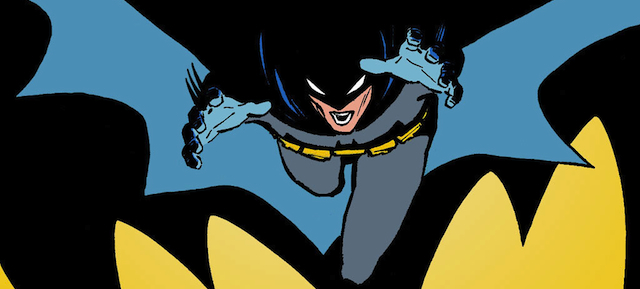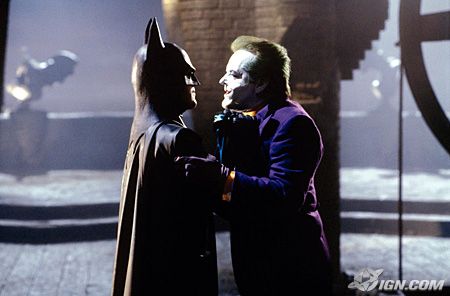
With The Dark Knight Rises primed to rock all our worlds this summer, we draw your attention back to the beginning of Jeremiah Lawson’s AKA Wenatchee the Hatchet’s epic series of posts on the mythology surrounding everyone’s favorite caped crusader, a certain half-Law Incarnate/half-Walking Wound named Bruce Wayne. Jeremiah has previously explored several other aspects of the philosophical, historical and theological underpinnings of the DC Animated Universe, e.g. the conflicted legacy of Superman and the roots of the Cartoon Revolution that the DCAU spearheaded.
“Better is the sight of the eyes than the wandering of the desire: this is also vanity and vexation of spirit.” Ecclesiastes 6:9
PART ONE: American Heroes at the End of History
 The end of the Cold War led to a seismic transformation of American pop culture. The Berlin Wall had fallen. The Soviet Union had collapsed. The Rebel Alliance had destroyed not only the last Death Star but also defeated the Emperor as well. In all sorts of ways the Cold War was ending faster than pop culture and political theorists could keep up. By the time Rambo III was released, the Soviet Union had already pulled out of Afghanistan, rendering the film redundant.
The end of the Cold War led to a seismic transformation of American pop culture. The Berlin Wall had fallen. The Soviet Union had collapsed. The Rebel Alliance had destroyed not only the last Death Star but also defeated the Emperor as well. In all sorts of ways the Cold War was ending faster than pop culture and political theorists could keep up. By the time Rambo III was released, the Soviet Union had already pulled out of Afghanistan, rendering the film redundant.
Neither the Soviet invasion John Milius imagined in Red Dawn nor the nuclear Armageddon imagined by James Cameron in Terminator actually transpired. Such was the apocalyptic fervor of the Cold War, so high were the stakes imagined, it was not possible to imagine any end to the Cold War except through nuclear holocaust or disarmament. The Cold War couldn’t really be over … could it?
Perhaps not coincidentally, Superman’s “quest for peace” proved he was a spent force on the silver screen, and comics sales were dropping. The Big Blue Boy Scout, who seemed like the embodiment of all that was supposed to be great about America, had somehow became a bit of an embarrassment (even if Superman IV hadn’t been such a poor movie!). If Superman represented the ideals of truth, justice and the American way and the United States survived while the Soviet Union collapsed, what did this mean?
It was as though the end of the Cold War had thrown Superman and all of Western culture into a strange existential crisis. We began to suspect that maybe T.S. Eliot was right, that the Apocalypse was not going to end with a nuclear bang but with a whimper. Francis Fukuyama began to talk about “the end of history” and how Western style democratic government and philosophy were the endpoint toward which humanity was moving. Meanwhile, Marxists continued to speak of late capitalism as if the fall of the Soviet Union signaled nothing more than a speed bump in the ultimate realization of proletarian revolution. Where could the Man of Steel possibly go?
As if to sum up this anxiety of post-Cold War purpose, Superman died defeating Doomsday, a monstrous creature of destruction, in 1992. It was as though DC had announced that Superman was dead and gone, no longer relevant to what America faced in a world without an Evil Empire. Never mind that Superman was brought back from the dead a mere eight months later and subjected to a series of reboots (even sporting a mullet), the symbolism was important.
 If Superman was on the wane in comics and the silver screen, and if Cold War pop culture narratives no longer applied, who would be the American comic book hero for this age? Even by 1989 an answer was clear: Batman. If Superman represented the unbridled optimism of America’s can-do spirit and a recognition of our power to change the world, Batman represents the “yeah, whatever” observation that we’re honestly not that awesome. It may sound grandiose, but Batman is the hero who recognizes that Eden has been lost. His personal “Eden” was lost when his parents were killed in front of him. Batman is fundamentally inspired by pain rather than duty – unlike the Man of Steel, his wound is the starting point of his power; Superman is literally a solar-powered super-being, while Batman is the (hu-)man of darkness. These are just a few of the aspects of the Dark Knight that we’ll be exploring in this series.
If Superman was on the wane in comics and the silver screen, and if Cold War pop culture narratives no longer applied, who would be the American comic book hero for this age? Even by 1989 an answer was clear: Batman. If Superman represented the unbridled optimism of America’s can-do spirit and a recognition of our power to change the world, Batman represents the “yeah, whatever” observation that we’re honestly not that awesome. It may sound grandiose, but Batman is the hero who recognizes that Eden has been lost. His personal “Eden” was lost when his parents were killed in front of him. Batman is fundamentally inspired by pain rather than duty – unlike the Man of Steel, his wound is the starting point of his power; Superman is literally a solar-powered super-being, while Batman is the (hu-)man of darkness. These are just a few of the aspects of the Dark Knight that we’ll be exploring in this series.
But Batman was not necessarily the hero we wanted. When the Tim Burton’s film came out, reviewers saw Batman as less interesting than his antagonist, the Joker. Tim Burton’s Batman was indebted to Frank Miller’s The Dark Knight Returns, which depicted a bitter, angry, even psychopathic vigilante who comes out of retirement as society and its capacity to restrain evil ages and crumbles around him. Tellingly, Miller’s Batman ultimately takes on the establishment itself in a battle with Superman, who had become the lapdog to the Reagan administration, having sold out to the worst excesses of Cold War moral simplification. And Burton’s Batman soon found himself at odds with the clueless and hopelessly bureaucratic forces of law enforcement. These mid-80s’ Batmen told us that it wasn’t enough just to fight for truth, justice, and the American way. Depending on which American way was being followed, truth and justice seemed nowhere to be found.
For people outside of America, it might be hard to fully appreciate how seismic and representative this pop culture eruption of inwardly directed criticism was. This was nothing less than a collective questioning of whether the very ideals and methods we had used to “win” the Cold War were worth the moral, social, and economic costs we paid. Tom Cruise’s Maverick was replaced with David Duchovney’s paranoid Fox Mulder. The 1990s were years in which The Cosby Show and Family Ties got supplanted by Seinfeld, Married: With Children, and, most importantly, The Simpsons.
The emergence of The Simpsons as the longest running comedy on television signaled several things. First and foremost it was a cartoon that satirized all of the things that had been held up as virtuous in the 1980s. Second and more revolutionary, it was animation geared toward adults, a form that had been reserved almost exclusively for children up until that point. The success of The Simpsons meant that cartoons were no longer just for kids.
Where The Simpsons revolutionized the larger pop culture landscape by making a cartoon for grown-ups, Paul Dini and Bruce Timm would revolutionize children’s’ entertainment by giving us with a cartoon that turned the values and aesthetics of 1980s cartoons on their heads. Here we had a cartoon that was not selling toys, that made use of talent from outside the animation profession, and one that would approach its storytelling enterprise first as art and second as commerce. Perhaps most importantly, Batman: The Animated Series would comprehensively destroy the moralism of 80s cartoons without succumbing to either satirizing Cold War values or unreservedly retaining them. America was going to get a cartoon Batman unlike any we had seen before. A cartoon revolution was under way.
For Part Two: Enter the Dark Knight, click here!
[youtube=http://www.youtube.com/watch?v=tgq3UaATX_U&w=600]
[youtube=http://www.youtube.com/watch?v=QUsQ259Ww4Q&w=600]

COMMENTS
Leave a Reply













